Greek food like souvlaki, gyros, and kebabs are probably the first things that pop into your mind when you think about what to eat in Greece. There may be the occasional plate of moussaka envisaged in there also.
This is likely served up in a traditional taverna with lots of plate smashing, Zorbas dancing and shouting “Oppa!” going on.
The reality is that Greek food is so much more than souvlaki, moussaka, and most of the dishes that you see served up in touristic places.
Understanding Greek Food
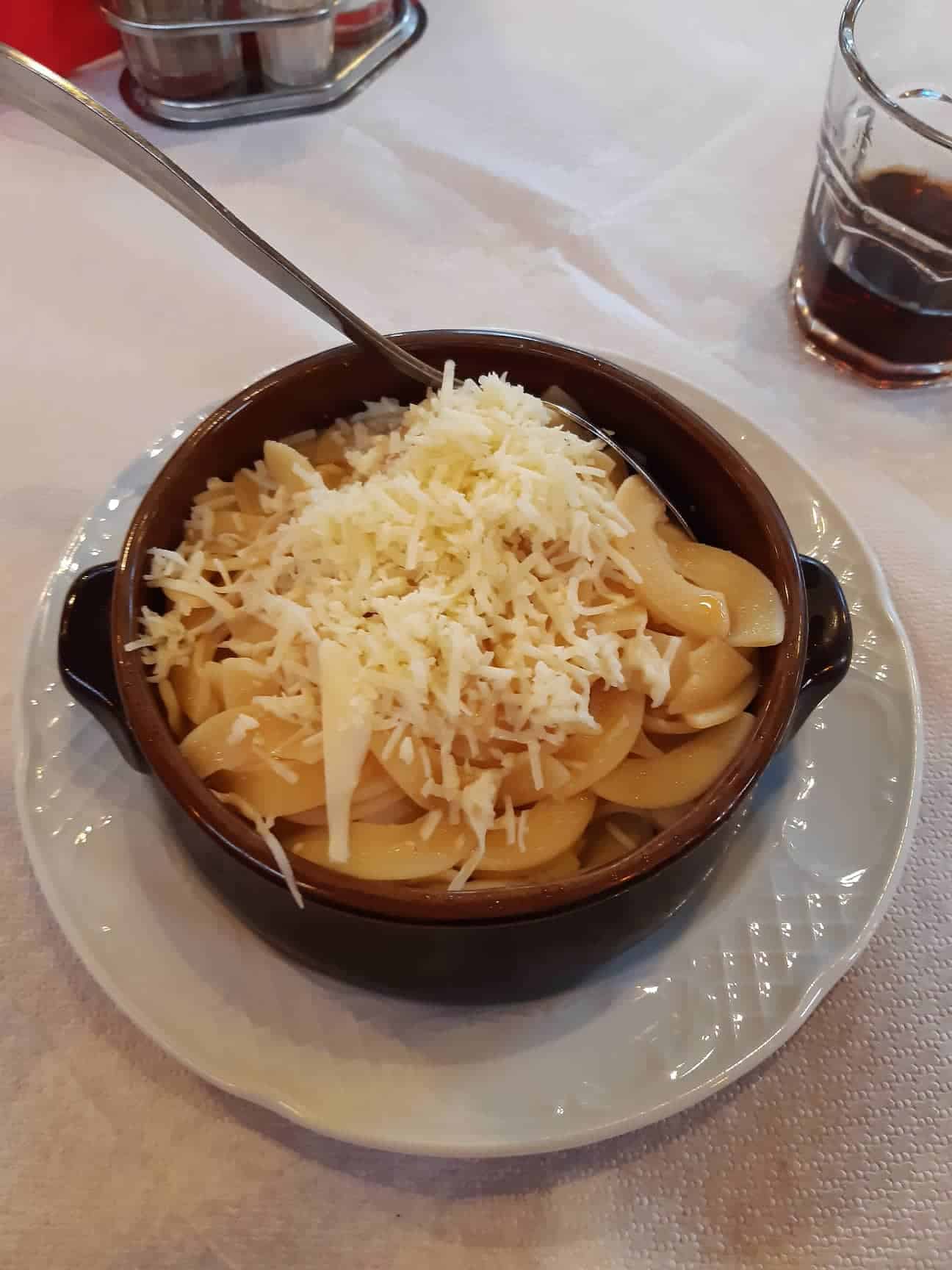
Greek food is more diverse than a lot of people realise. There are also many sumptuous, healthy Greek dishes that are suitable for vegans and vegetarians. It is an incorrect stereotype that Greek food is simply restricted to meat dishes.
Greek Food and its Links with the Ottoman Era
Greece was occupied by the Ottoman Turks for many centuries. As such, the national cuisine shares a lot of similarities with Turkish food.
There are a lot of dishes which the Turks claim to be their creation, yet the Greeks claim to be theirs, and vice versa. There is definitely a distinct difference in the cooking styles. However, it is interesting to observe the similarities.
Greek Food Varies Across the Country
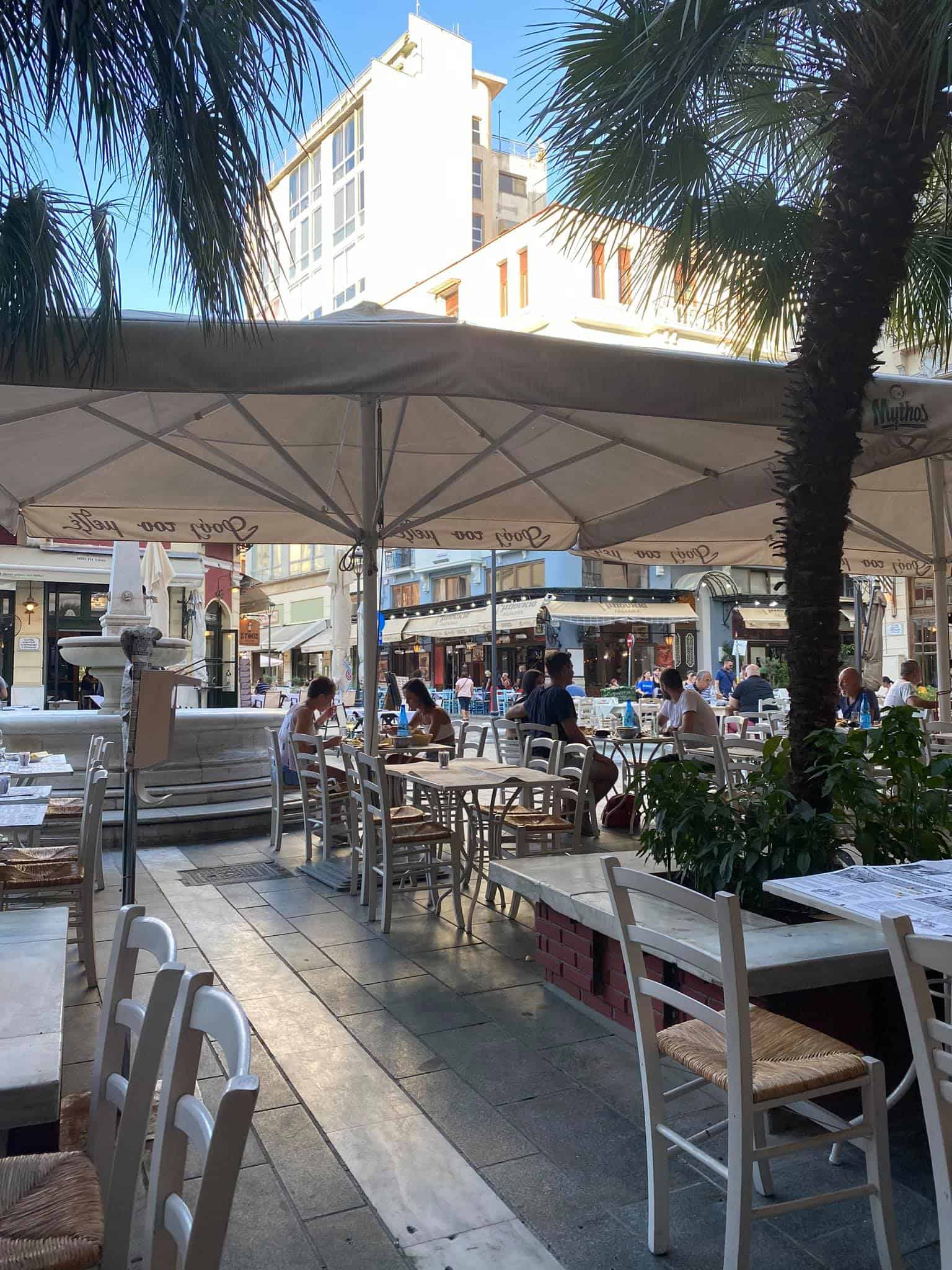
Different parts of Greece have their own distinct local specialties. Of course, there are quintessential taverna classics that you can find nationwide. However, there are also regional dishes that you will not easily find outside of a specific area.
For instance, a popular Corfiot dish on the island of Kerkyra (Corfu) is sofrito. This is a mouthwatering meat dish that is prepared by cooking tender cuts of veal or beef in an abundance of garlic, white wine, butter and parsley. The sofrito is then commonly served with fries.
Similarly, Skopelos island is renowned for its locally grown plums and olives. Skopelos restaurants serve island delicacies such as slow-roasted pork cooked with Skopeliti plums and apricots, or chicken stuffed with plums, chicken liver, herbs, and walnuts. You will struggle to find these dishes outside of the Sporades.
Meat Plays a Major Role in the Greek Diet
A typical Greek diet contains a lot of red meat. An awful lot of red meat. So much red meat that it makes you wonder if cows, pigs, and whatever else are on the brink of extinction in Greece.
So much red meat that you wonder how these people are actually functioning and not keeling over and having a heart attack in broad daylight. This is a joke, of course.
There is a lot of meat commonly eaten as part of the Greek diet. However, fresh, locally sourced vegetables, delicious salads, and organic fruits offset the impact.
What to Eat in Greece:
The Best Greek Foods to Try
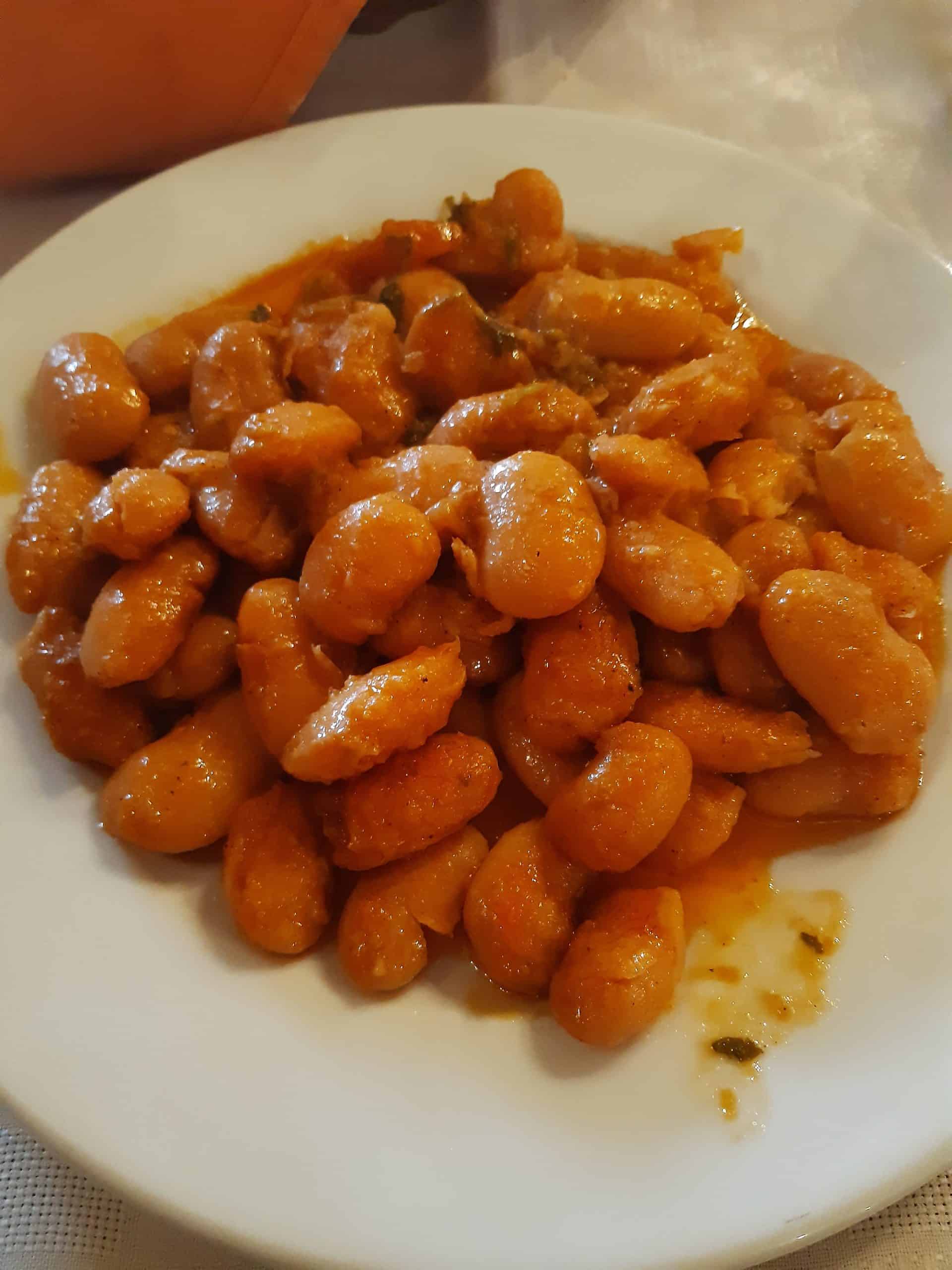
This article is fairly comprehensive. It breaks down the most popular Greek food dishes by category. Feel free to use the table of contents to navigate to the most relevant sections.
There are hundreds of different delicious Greek recipes. You will probably not have time to try them all during your Greece itinerary. The most popular dishes that you absolutely must sample during your first trip to Greece are detailed below.
- Gyro
- Souvlaki
- Pastitsio
- Moussaka
- Baked feta or Saganaki (fried cheese)
- Fava bean puree
- Tzatziki
- Lamb kleftiko
- Loukoumades
- Greek coffees
What to Eat in Greece:
Light Snacks and Pastries
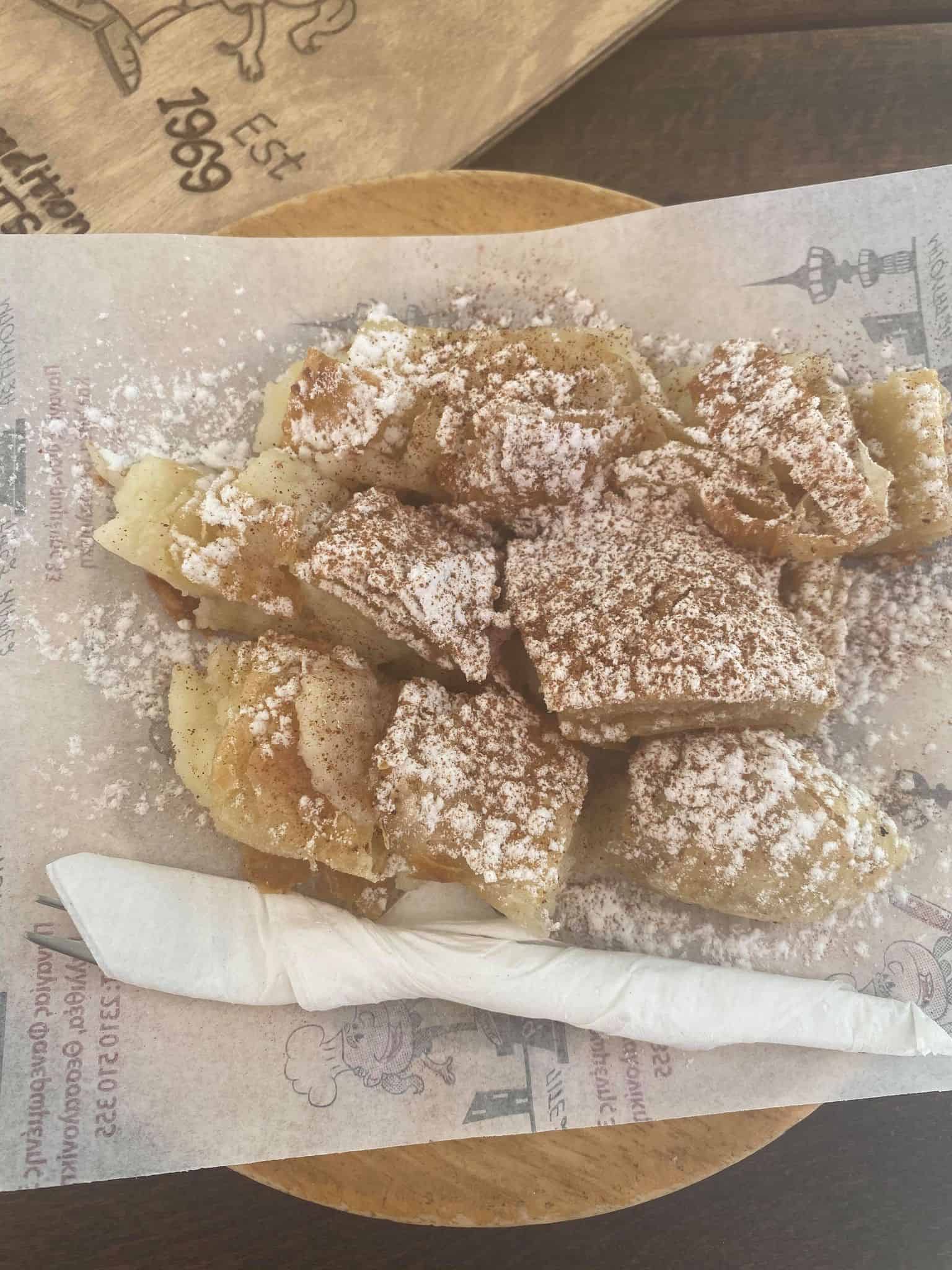
Bakeries in Greece can be found on virtually every street corner. They are open from super early in the morning to late at night.
The smell of freshly prepared cakes and savory treats wafting outside is a treat every time you pass. People will regularly stop by their local bakeries to purchase delicious crumbly tiropita and spanakopita pies to eat at home with Greek yoghurt and salad, or to buy warm, fresh-baked bread for their homemade soups.
Spanakopita
Spanakopita is arguably the most popular Greek pie. This delicious pastry consists of flaky, crispy phyllo dough that is stuffed with fresh spinach, feta cheese, onions, and herbs.
It is a popular light bite to enjoy as a savoury breakfast treat or a lunch. Vegan alternatives are now also sold at Greek supermarkets.
You will find spanakopita on sale at every bakery, virtually every hour of the day. Portions are usually generous. A huge slab the size of your head costs no more than 2 euros.
Koulouri
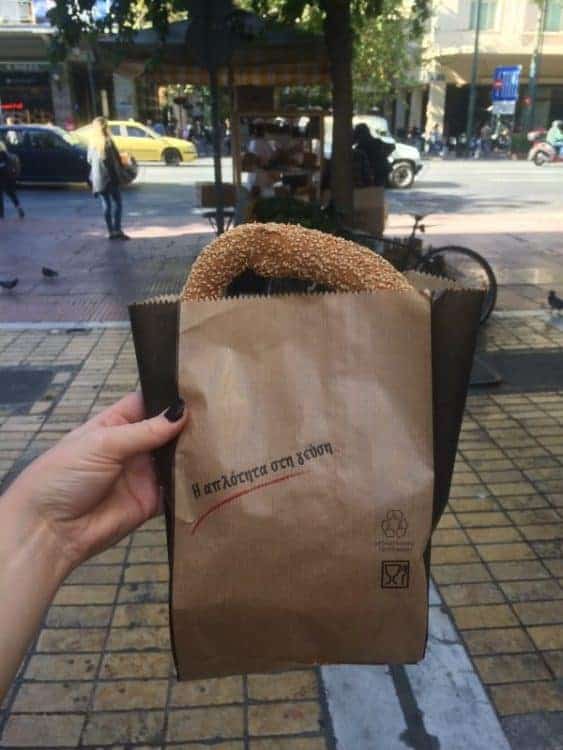
Koulouri is the Greek food answer to the New York pretzel. This popular snack originated in Thessaloniki in northern Greece. Traditional koulouri is circular sesame seeded bread that is served warm.
A lot of Greek bakeries sell koulouri. Additionally, you will find many specific koulouri vendors n the streets of Athens and other urban areas.
You can also find lots of unusual variations of koulouri. For instance, koulouri stuffed with cheese and ham, chocolate, etc are also popular variations.
Tiropita (Feta Cheese Pie)
Tiropita pies are essentially the same as spanakopita but without the addition of spinach. Layers of phyllo pastry are filled with cheese and egg.
One tiropita pie is filling enough to feed all of Greece! A more modern and lightweight alternative option to this is to take one of the sesame Philadelphia filled roll pies.
Bougatsa
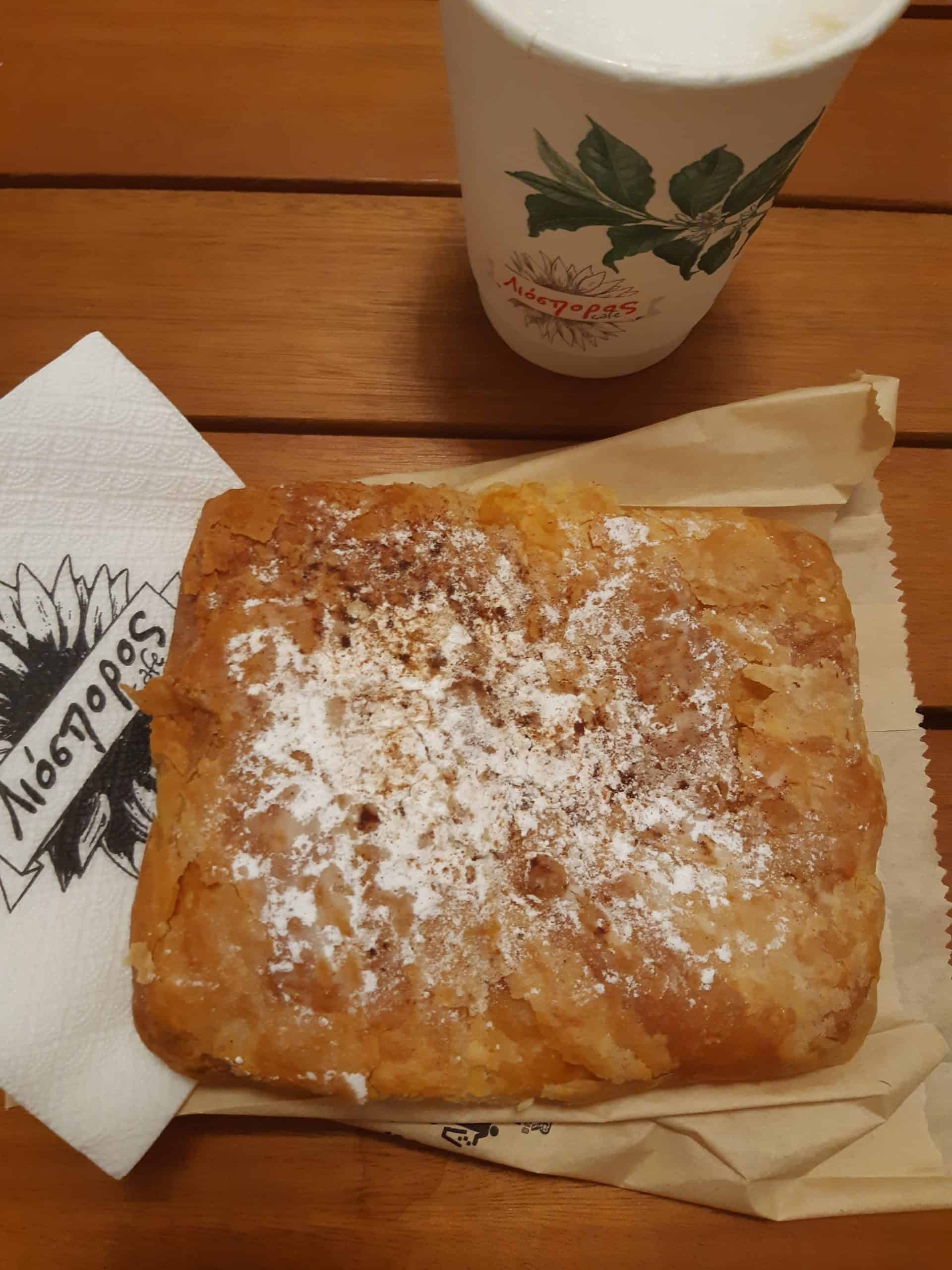
A sweet Bougatsa is Greece’s signature dessert pastry. This is commonly enjoyed at breakfast with a steaming cup of Greek coffee.
Semolina custard is tucked inside layers of crispy phyllo. Then, icing sugar and cinnamon are sprinkled over the top.
Making Bougatsa
Bougatsa originated in Thessaloniki. One of the best restaurants in Thessaloniki is the Bougatsa Bantis pastry store. Bougatsa Bantis is one of the earliest bougatsa bakeries in Greece.
The process of preparing bougatsa is very interesting to witness. The pastry chefs spin the raw phyllo around over their heads to “air it out”.
Variations of bougatsa also exist. Savoury versions are sometimes prepared with minced meat. Bougatsa Thessaloniki is a slightly touristic but charming bougatsa spot in Plaka that you may want to try out as part of your Athens itinerary.
Greek Food:
Light Bites & Appetizers
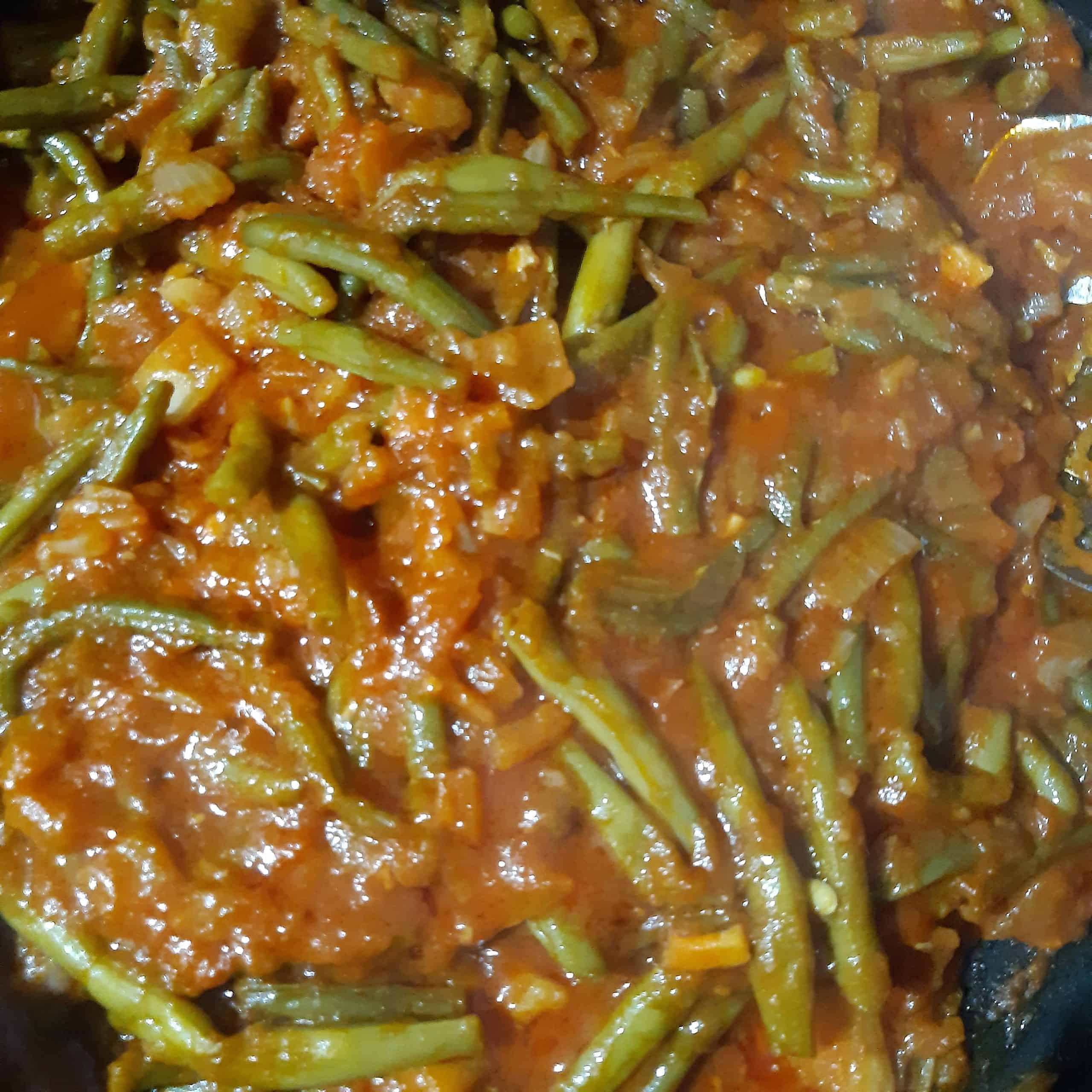
A lot of vegetarian Greek food dishes are often prepared as appetisers or mezes to share with the table. That said, nobody will judge you if you decide to eat an appetiser as a main. Greeks themselves will often cook up steaming hot bowls of fasolakia at home and then enjoy it with crumbled feta cheese sprinkled over the top.
Saganaki
Saganaki is a quintessentially Greek appetiser that your tastebuds will thank you for but your waistline will not!
The dish is made by pan-frying cheese in olive oil. Balsamic vinegar is then drizzled over the top.
Flavourful variants of balsamic vinegar are often used for saganaki. For instance, balsamic infused with figs or pomegranate.
Saganaki varies from place to place depending on the type of cheese used. Kefalotiri and manouri cheese are among the most popular variations. You will find saganaki on the menus of most tavernas.
Tirokroketes
Tirokrkoetes (stuffed cheese balls) are a very popular appetizer in Greek tavernas. You can find these almost everywhere. The dish costs just a few euros and is a nice meze item to share with friends.
Fava Beans Puree
Fava beans puree is a delicious meze dish that is perfect when accompanied by a side order of warm pita bread. The dish originated in Santorini and consists of pureed yellow split peas/fava beans that are served with red onions, parsley, and lemon. This dish makes an appearance on most taverna menus.
Kolokithokeftedes
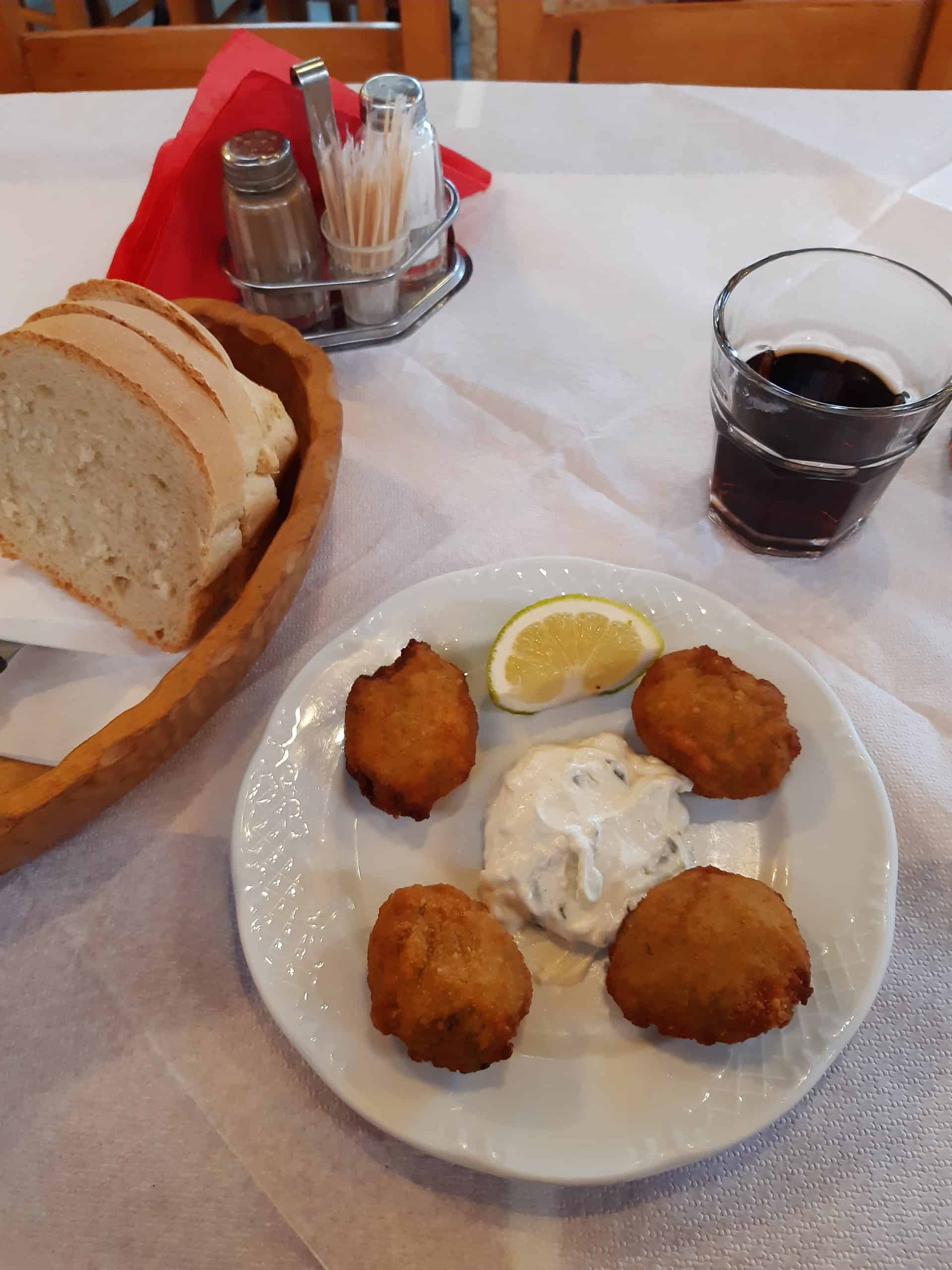
Kolokithokeftedes is a nice vegetarian Greek food option. You can order these as a starter or a meze when you dine out at restaurants and tavernas.
This dish is simple yet incredibly tasty. Kolokithokeftedes is simply zucchini fritters that are fried and served with feta cheese. Yum!
Fasolakia (Greek Braised Green Beans)
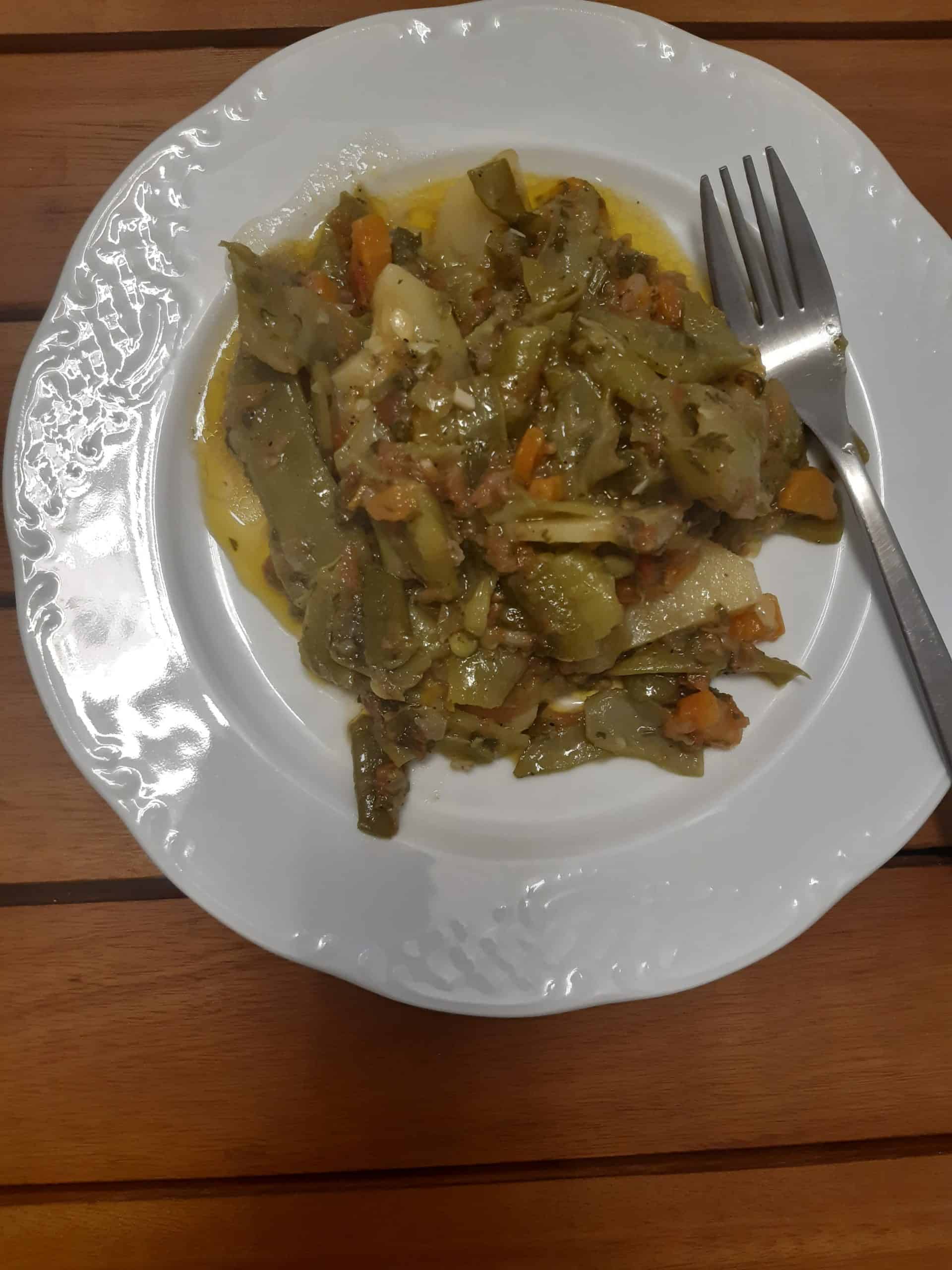
Fasolakia is a Greek food dish that is super healthy, flavourful, and vegan. Green beans are slow-cooked for an hour in a tomato sauce that is filled with sauteed potatoes, garlic, onions, and herbs.
This process gives the beans a delightfully soft texture that is comparable to tagliatelle pasta. Fasolakia is served with a side of warm pita bread and crumbly feta cheese.
Yemista
Yemitsa is a popular dish all over the Greek islands and mainland from Athens to Alonissos. Plump, fresh tomatoes, and juicy bell peppers are stuffed with rice, herbs, and spices.
Yemitsa is generally a healthy and flavourful option for vegetarians. However, some variations do contain minced meat so it is important to check the speciic recipe before you order.
Greek Salad (Horiatiki)
Greek salads (Horiatiki) are so simple, yet so well-loved around the globe. It may come as a surprise to learn that there is actually no lettuce in a Greek salad.
Horiatiki contents vary. However, cucumber, bell pepper, onion, tomatoes, and olives are common ingredients.
Greek salads are usually topped with feta cheese and drizzles of olive oil and balsamic vinegar. Locals do not order this as a main dish as many tourists do. A portion of horiatiki is shared among everyone at the table.
Feta Cheese
Soft, creamy, delicious feta is a staple at any Greek dinner table – be it at home or in a taverna. This is the nation’s favourite cheese. An interesting fact about Greece is that Greeks eat approximately 80,000 tons of feta every year!
Feta is created by combining goat’s and sheep’s milk. It is a protected Designation of Origin item (PDO). It cannot be produced outside of Greece.
A slab of feta cheese sprinkled with oregano and drizzled in olive oil accompanies practically every meal. Feta is also sometimes baked for a little something different.
Tzatziki
Tzatziki is a staple Greek condiment. Go over to any Greek friend’s house and you will likely find huge tubs of homemade tzatziki in their fridge.
Tzatziki is simple to make. Greek yoghurt is mixed with chopped cucumbers, olive oil, garlic, and salt. Various tzatziki recipes exist. The exact contents vary from taverna to taverna.
You can order a serving of tzatziki at restaurants and tavernas for just a few euros. It makes the perfect dinner accompaniment for dipping your fries or bread into. Generous servings of tzatziki are also often poured over gyros and souvlaki.
Melitzanes Papoutsakia
Greek papoutsakia is essentially a lighter version of moussaka. The dish is made by stuffing eggplants with meat and bechamel sauce. Next, the eggplants are baked in the oven until they are crunchy and golden.
Small plates of papoutsakia are a popular meze lunch dish. This is essentially like having little bite-sized portions of moussaka.
Taramasalata
Taramasalata is a popular meze dip. The salted, cured roe of a fish (commonly cod) is pureed and then flavoured with onions, garlic, olive oil, and lemon juice. Taramasalata is commonly spread over bread and enjoyed with ouzo.
Kebabs, Gyros, and Greek Fast Food
Street food culture is huge in Greece. Greeks will often grab a couple of souvlaki sticks wrapped in pita bread as they head home after a night out in Athens.
Souvlaki
Souvlaki may come to be something that you see a little too much of during your time in Greece. However, these marinated meat skewers are the nation’s favourite late-night treat after a glass or two of ouzo.
Marinated meat that has been cooked over an open fire. You can get beef, pork, or chicken variations of souvlaki.
The meat is served on a stick with a slice of lime and a piece of crusty bread or pita on the side. One souvlaki stick usually costs around €1.40.
Yogurtlu Kebab
Many tavernas and kebab houses are scattered through the streets of Athens and other Greek cities. The dishes that they serve have both Greek and Turkish roots.
Yogurtlu kebab (Yoğurtlu Köfte Kebabi) is a dish with Turkish origins that makes a frequent appearance on Greek menus. This Greek food dish consists of a mixed lamb and beef kofte kebab served with an abundance of delicious Greek yogurt, fresh tomato sauce with herbs, and pieces of pita bread.
Cheese Stuffed Keftedes
Just when you thought that you couldn’t feel any more guilty eating big mounds of marinated meats and kebabs, the Greeks find a way! These keftedes are delicious marinated meat kebabs whose insides are stuffed with melted cheese.
As you cut inside the meat, the melted cheese pours out forming a sumptuous melty, cheesy, meaty mess. Different parts of Greece use different cheeses inside the kebab. This is often their beloved feta. However, gouda and roquefort are also used.
Gyros
A Greek gyro is made using beef, pork, or chicken. The meat is prepared on a rotisserie before being served with fries, chopped onions, and salad. Then, the ingredients are wrapped in pita bread.
Gyros are usually accompanied by a dollop of either tzatziki or a unique local sauce made up of mustard mixed with mayonnaise. The latter is much tastier than it sounds!
Classic Homemade Greek Food
The dishes contained here are the homemade classics that Greeks will often enjoy at home with their families. They are great choices when wondering what to eat in Greece though, and can be found at many tavernas and authentic Greek restaurants.
Supermarkets and some buffet-style eateries also serve a lot of these dishes. You can take home single portions for just a few euros.
Moussaka
Moussaka has to be one of the most iconic dishes in Greece. You should try it at least once.
Greek moussaka could be compared to lasagne but without the pasta. It consists of minced meat (typically lamb), aubergines, onions and vegetables and of course, a creamy bechamel sauce.
Pastitsio
Pastitsio possesses a lot of similarities to moussaka. However, penne-style pasta is added to this dish. Pastitsio is moussaka on crack if you will.
The dish consists of ground meat (beef or lamb), lines of penne pasta and delicious bechamel sauce. If you order this dish at a restaurant, it is typically served piping hot in an adorable single-portion ceramic dish.
Dolmas
Dolmas are stuffed grapevine leaves. You may have tried this dish before if you have travelled around Eastern Europe or the Middle East. Numerous countries have their own variations of dolmas.
Dolmas are served hot and are often stuffed with pine nuts, herbs and cooked rice. Vegetarian versions are often available.
Lamb Kleftiko
Food and family are two of the most important things in Greek culture. The Greeks will sit down and enjoy meals together as the rule, not the exception.
Sunday is a special day in Greece. Lamb Kleftiko is a beloved dish that is often enjoyed on a Sunday afternoon.
Slow-cooked roasted lamb is prepared with garlic, lemon, and herbs. The dish is then served with seasoned potatoes. The lamb is so tender that it seemingly falls away from the bone.
Lavraki (Sea Bass)
Grilled fish is very popular in Greek cuisine, especially on the islands. This is not surprising. The county’s close proximity to the Aegean and Mediterranean seas means that there is no shortage of fresh catches.
Lavraki is a particularly beloved Greek food dish. This Mediterranean sea bass is indigenous to Greek waters.
Historically, this fish was notoriously difficult to catch. It has even been written about in Greek legends!
Lavraki can be ordered at seafood restaurants on the islands, and coastal areas of mainland Greece. The fish is grilled and marinated, creating a tender, buttery texture.
Calamari
Almost every ouzeria and fish taverna in Greece sells calamari. Fresh catches of the highest quality are sourced daily in the Mediterranean.
Greek calamari is simple yet tasty. The squid is fried and then seasoned with olive oil, lemon, salt, and parsley.
Stifado
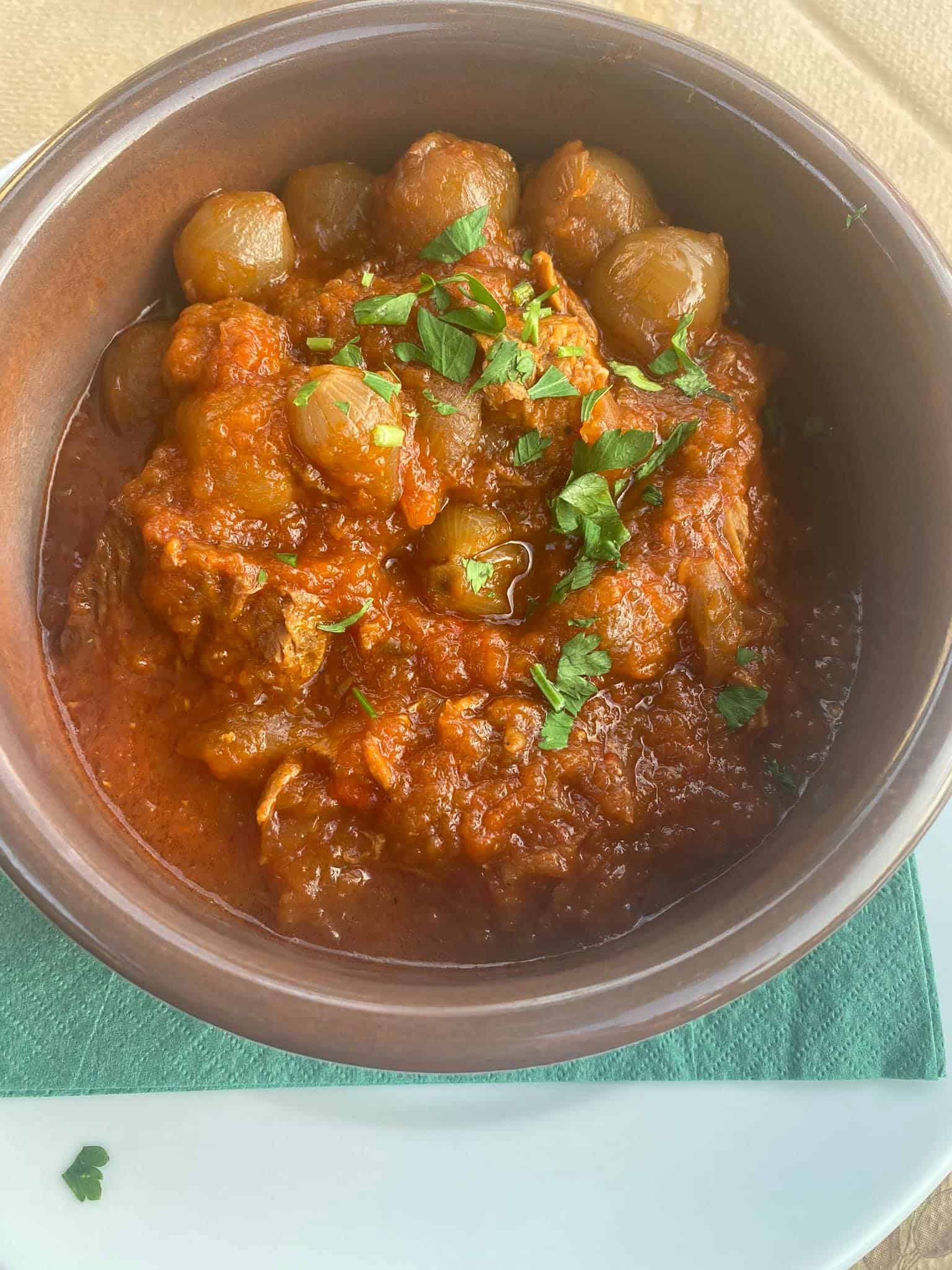
Stifado (Greek beef stew) can be ordered in a lot of traditional restaurants and tavernas. This Greek food dish provides a glimpse into wonderful home cooking prepared by a Greek yiayia.
The beef is marinated overnight and cooked in a hearty tomato broth. This cooking method makes the beef tender and juicy. The meat simply melts in your mouth. Onions, vinegar, wine, and spices are added to stifado to create a dish that is bursting with flavour.
Kritharaki
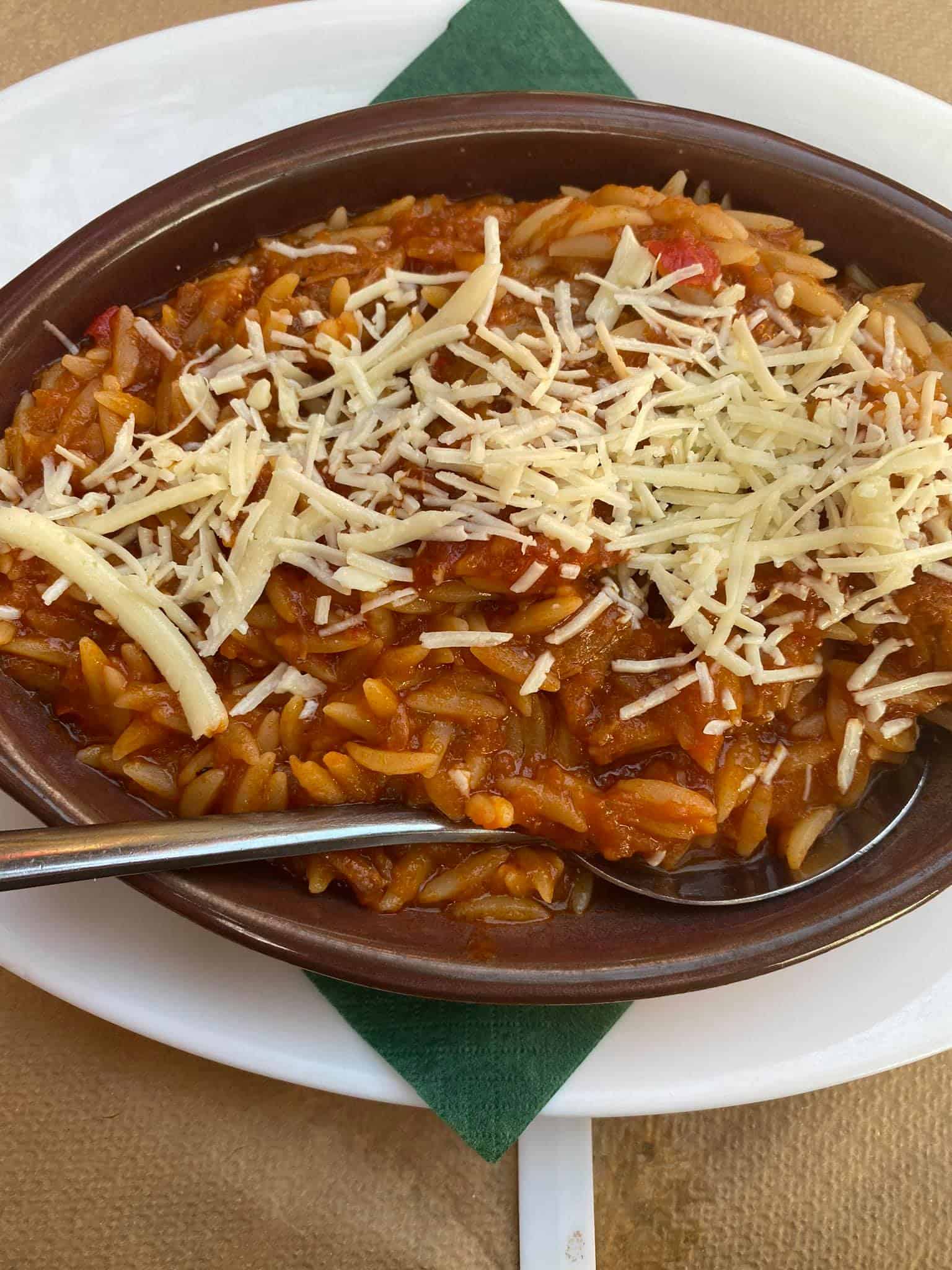
Kritharaki is a type of short pasta that resembles rice. It is also known as “orzo”.
There are different variations of Kritharaki dishes in different regions of Greece. The pasta can be enjoyed alone as a main meal, or as a side dish.
Giouvetsi is a popular way to enjoy orzo, especially during winter in Greece. The pasta is prepared with tomato sauce, onions, garlic, and tender beef, lamb, or chicken.
What to Eat in Greece:
Sweet Treats
No meal is complete without a Greek dessert. Fortunately, there are plenty of sweet treats to be found and enjoyed in the islands and the mainland of Greece. Many restaurants in Athens will serve you a complimentary dessert after your main course.
Loukoumades
Loukoumades are the Greek answer to the doughnut. They have a kind of dumpling-style appearance instead of being circle shaped with holes in the middle.
Better still, loukoumades are often stuffed and topped with sweet fillings. Individual portions of loukoumades come in boxes of between 12-16 pieces. Typically you will choose a filling sauce for the inside, and a topping sauce to cover.
Expect a list as long as your leg for your options of sauces! Loukoumades can be topped and filled with everything imaginable – from Bavarian cream to Nutella.
Halva
Halva is a dessert that has roots in Middle Eastern cooking. It has a unique texture and can be made with either sesame or semolina flour.
The dessert has a sort of chalky, nougat-like consistency. If you go shopping in Athens, you will find excellent halva at the market stalls on Evripidou street.
Halva can be found in different variations. Sometimes it is made with chocolate, other times with cinnamon, etc.
Melomakarona Cookies

Photo Credit: mpessaris/Shutterstock.com
When the Christmas period starts approaching in Greece, the bakeries here start making and selling melomakarona biscuits. Melomakarona are soft handmade biscuits that are dipped in syrup and honey before being covered in grounded walnuts. Sometimes you can also find them covered in chocolate.
Baklava
Syrupy, sweet, and sticky, you can find tray after tray of different varieties of baklava piled high in Greek bakeries. The pastry is prepared by filling layers of phyllo pastry with chopped nuts such as pistachios. Honey and syrup are then used to hold the layers in place.
Baklava is a popular dessert in Greece, Turkey, and the Middle East. Each country and bakery place their own personal spin on the treat.
Portokalopita (Greek Orange Cake)
Phyllo pastry is everywhere in Greece. It is used in savoury pies like spanakopita, and it is known for giving desserts like bougatsa their je ne sais quoi.
However, not everyone is a fan of the texture of phyllo pastry. If you fall into that category, give portokalopita a chance. It may well just change your mind.
Portokalopita is a delightfully sweet, sticky, and sinful Greek cake. It is made of handmade phyllo pastry that has been shredded and then stuck together again with an orange and cinnamon syrup.
Greek Coffee

Coffee culture is huge in Greece. Half a dozen coffee shops are scattered on virtually every street.
Coffee drinking is essentially the national sport of Greece. However, Greek coffee is very different from coffee enjoyed in the rest of Europe.
You can still get flat whites, Americanos, and cappuccinos in Greece. However, you should also try something new and distinctly Greek.
Freddo Cappuccinos and Espressos
The modern Greek way to drink your coffee is to take it “Freddo” or iced. Temperatures in Greece often soar well over 25-30 degrees. As such, it’s nice to have a cold refreshing coffee to cool you down.
Espresso is blended with ice and served over ice cubes to form a Freddo espresso. Cold foamed milk can be added to the top to make a Freddo cappuccino. It is also possible to order your Freddo cappuccino with cream for the ultimate indulgence.
Traditional Greek “Hot” Coffee (Ellinikos Kafes)
Traditional Greek coffee or “ellinikós kafés” is a small, strong bitter cup of hot coffee. It is actually the same as Turkish coffee. This beverage was bought to Greece by the Ottoman Turks.
Most young people in Greece tend to prefer drinking iced coffee. However, you can still find a lot of traditional coffee stores serving ellinikós kafés tucked away down Athenian alleyways.
It is mostly the older Greeks that sip this coffee while sitting outside al fresco and playing backgammon. It is served in a little copper pot or ‘biriki’. Ellinikós kafés” is commonly enjoyed with loukoum, Greek Turkish delight.
What to Drink in Greece:
Unique Alcoholic Beverages
Ouzo is essentially the national drink of Greece. It is rare to walk past a group of Greeks enjoying mealtime and not see a bottle of ouzo or two among the plates.
The alcoholic tipple originates from Lesvos island,. It has a strong aniseed flavor and is typically enjoyed neat over ice.
Raki is the Cretan alternative to Ouzo. It possesses some similarities in terms of flavour. However, where tsipouro is a distilled Greek pomace brandy.
All of these Greek alcohols are synonymous with the food sharing culture and the idea of having good times with friends.
Rakomelo
Rakomelo is made by mixing Cretan raki with honey. Cinnamon and cardamom are then added for an extra kick.
Many tavernas and restaurants in Greece make their own Rakomelo. This is served warm after a meal as a digestif.
Rakomelo is also considered to be a home remedy when you get sick. It is kind of the alcoholic Greek alternative to having a hot honey and lemon.
What to Eat in Greece:
Practical Tips for Finding Greek Food
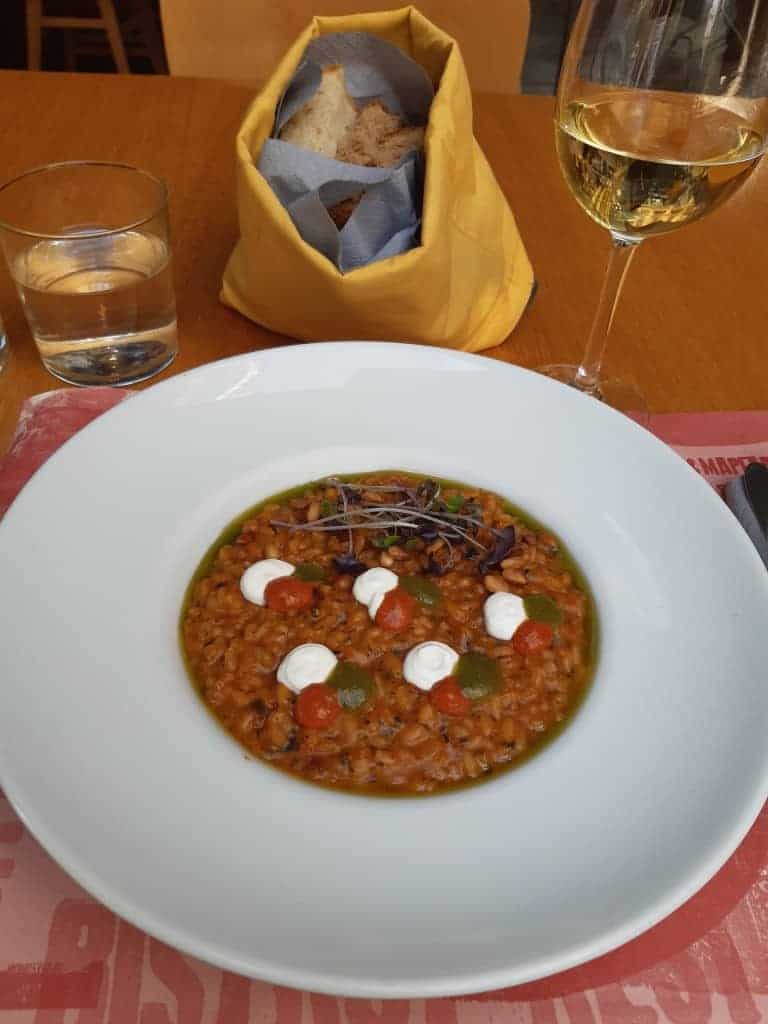
Be mindful of the types of restaurants you dine at in Greece. Avoid dining at touristic restaurants close to major attractions if you can. Restaurants close to sites such as the Athens Acropolis often charge as much as three or four times the regular price.
Take Local Recommendations on Where to Eat in Greece
Take local recommendations on where to eat in Greece. Ask your hotel owner, Airbnb host, or local friends what their favourite restaurants are. Don’t spend $15 on a sloppy moussaka next to the Acropolis hill when you could enjoy one for $6 in an authentic taverna.
Try Out the Greek Food Convenience Culture
Greece is pretty good in terms of convenience. E-Food is our answer to Uber Eats. Another useful food delivery platform is Wolt.
These platforms allow you to order deliveries from local restaurants, souvlaki spots, and bakeries. The minimum order amounts are often as low as 2 euros and it’s not just junk food.
Shop at Local Markets for Greek Food (Laiki)
Try and check out a laiki agora while in Greece. These are local farmer’s markets.
Most neighbourhoods in Greek cities and towns have their weekly laiki. This is a great place to people watch as well as to pick up some great, affordable organic fruit and veg if you are staying in self-catered accommodation.
Embark on a Food Tour
A Greek food tour is a great way to see a certain town or city “like a local”. These tours enable you to try numerous local delicacies at once. Additionally, they take you to restaurants and marketplaces that you may not stumble across by yourself.
Parting Words
I’m hoping that after reading this guide, you won’t feel stuck when wondering what to eat in Greece! Have any more questions on what to eat in Greece, Greek food or Greece travel in general? Feel free to reach out and let me know. I live here!

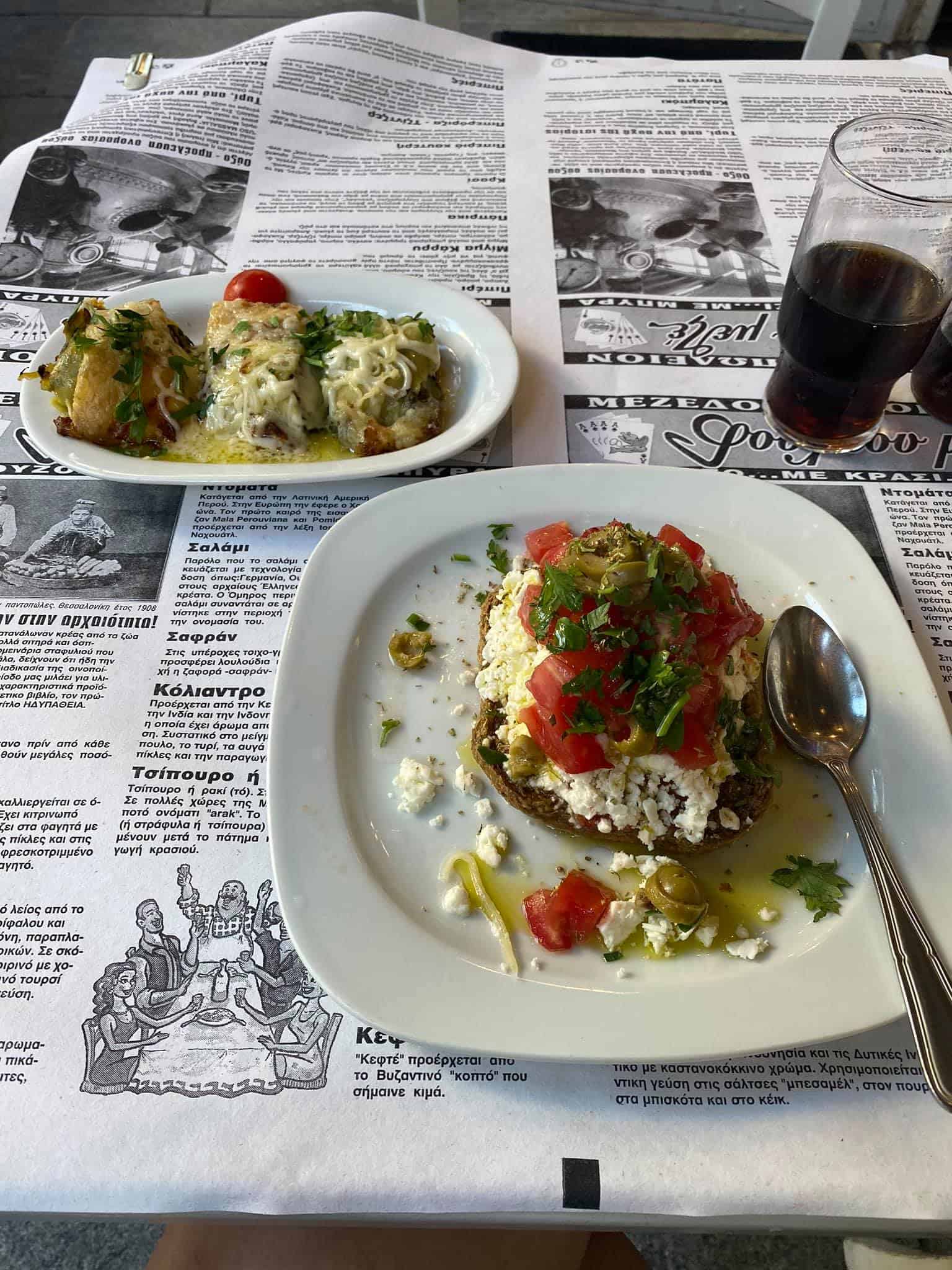




1 Response
This is a beautiful summary of Greek food and also very clearly written in a highly readable font. Congratulations! It has to be in the top 10% of useful websites on the internet.
What surprises me is that the humble chicken doesn’t seem to get a look-in in the Greek diet. This is rather extraordinary for a Mediterranean country, or am I missing something?
Thanks for all the useful info. I’ll carry this with me next time I go to Greece and am looking to avoid all the corny food supplied in tavernas just to fulfil tourist expectations. God save me from another moussaka!